“They Taught with Power and Authority of God”

The Sons of Mosiah2 Return: Alma 17:1-4
17:1 We last heard of these young men in Mosiah 28:9
17:4 “…for the space of fourteen years…” This is from about -91 to -77BC
An Account of the Missionary Journeys of the Sons of Mosiah2: Alma 17:5 – 27:15
The Sons of Mosiah2 Begin Their Missionary Labors: Alma 17:6-17
17:12 For more details of their journey through the wilderness, see Alma 26:26, 27.
17:14 Here we get more of the typical racist caricature of the Lamanites made by a Nephite. I found the following excerpt from a 1947 Life Magazine article titled, “How to Tell Japs from the Chinese”, very enlightening:
“U.S. citizens have been demonstrating a distressing ignorance on the delicate question of how to tell a Chinese from a Jap. Innocent victims in cities all over the country are many of the 75,000 U.S. Chinese, whose homeland is our stanch ally. So serious were the consequences threatened, that the Chinese
consulates last week prepared to tag their nationals with identification buttons. To dispel some of this confusion, LIFE here adduces a rule-of-thumb from the anthropometric conformations that distinguish friendly Chinese from enemy alien Japs.
To physical anthropologists, devoted debunkers of race myths, the difference between Chinese and Japs is measurable in millimeters. Both are related to the Eskimo and North American Indian. The modern Jap is the descendant of Mongoloids who invaded the Japanese archipelago back in the mists of prehistory, and of the native aborigines who possessed the islands before them. Physical anthropology, in consequence, finds Japs and Chinese as closely related as Germans and English. It can, however, set apart the special types of each national group.
The typical Northern Chinese, represented by Ong Wen-hao, Chungking’s Minister of Economic Affairs (left, above), is relatively tall and slenderly built. His complexion is parchment yellow, his face long and delicately boned, his nose more finely bridged. Representative of the Japanese people as a whole is Premier and General Hideki Tojo (left, below), who betrays aboriginal antecedents in a squat, long-torsoed build, a broader, more massively boned head and face, flat, often pug, nose, yellow-ocher skin and heavier beard. From this average type, aristocratic Japs, who claim kinship to the Imperial Household, diverge sharply. They are proud to approximate the patrician lines of the Northern Chinese.”
17:14-17 These verses are an editorial interpolation by Mormon; the narrative resumes in vs. 18.
Ammon3 in the Land of Ishmael: Alma 17:18-21:23
Ammon3 Goes to the Land of Ishmael: Alma 17:18-25

17:16 “…according to the custom of the Lamanites…” Grant Hardy calls this type of editorial interruption made by Mormon and “explanatory detail”. This account with King Lamoni hardly makes the Lamanites look a “wild and a hardened and a ferocious people…”
Ammon3 Defends the King’s Flocks: Alma 17:26-39
17:26 “…Lamanitish servants…” Why not just say “Lamanite servants”? It just sounds weird.
17:27 Flocks of what? The text does not say.
17:31 The words flatter, flattereth, flattered, etc. occurs 21 times in the Book of Mormon. This is the only time it is used to describe the words of a “righteous” Nephite. The Sons of Mosiah are part of the “unbelievers” described in Mosiah26:6 & Mosiah27:8. Mormon uses the word “flattery/flattering” to describe the unbelievers. This word does not occur again after Mosiah 27:8 until Alma 17:31.
17:35 “…the Lord had promised Mosiah that he would deliver his sons out of their hands…” This is in fulfillment of Mosiah 28:7. Prophecies provide connections between larger episodes, and even between books, as when Mormon spends considerable effort explaining Ammon’s miraculous preservation by referring to a previous revelation from God given to his father , King Mosiah.
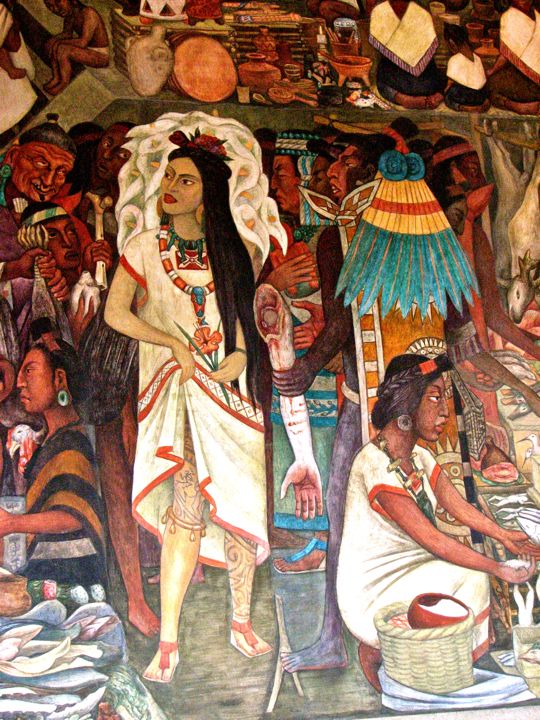
This is a detail from one of the famous Diego Rivera murals at Mexico Palacio Nacional in Mexico City. It depicts a Mexica woman, probably a prostitute, displaying the intricate tattoos on her legs to potential customers. One warrior offers her a human arm for her services.Rivera modeled this woman after his wife artist Frida Kahlo
17:38 “Now six of them..and he smote off as many of their arms…” Grant Hardy calls this editorial interruption by Mormon an “explanatory detail” Why does Mormon feel compelled to give this editorial interruption?
Click here to read an article about the Mesoamerican cultural pattern of cutting off enemies’ arms
The Testimony of King Lamoni’s Servants: Alma 18:1-11
18:9 “..he is feeding thy horses.” This is anachronistic. What are some of the apologetic responses? Here is what a non-LDS scholar has said about horses in central Asia:
The horse was the basis of the wealth and military power of the Huns of central Asia (fourth and fifth centuries A.D.). Nonetheless, according to S. Bokonyi, a leading authority on the zoological record for central Asia, We know very little of the Huns’ horses. It is interesting that not a single usable horse bone has been found in the territory of the whole empire of the Huns. This is all the more deplorable as contemporary sources mention these horses with high appreciation. (S. Bokonyi, History of Domestic Mammals in Central and Eastern Europe (Budapest: Akademiai Kiado, 1974), 267).
The argument then goes, if horse bones cannot be found in Asia where the Huns ruled, can we expect to find horse bones in the warm tropics of Mexico and Central America?

The infamous Tapir varies between types, but most tapirs are about 2 metres (7 ft) long, stand about a metre (3 ft) high at the shoulder, and weigh between 150 and 300 kg (330 to 700 lb)

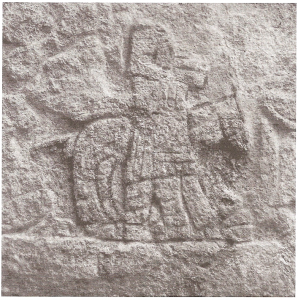
Some think this looks like a man next to a horse. It seems to be a bit of a stretch. Temple of Palques, Chichen Itza, Yucatan Mexico.
18:10..preparing his horses and chariots…” Chariots have wheels. There is not indication that the Mesoamericans used the wheel for transportation. Although toys have been found with wheels on them, there is no archaeological evidence of the wheel being used for labor. Does the Book of Mormon indicate what was meant by chariot? Does the text detail King Lamoni being carried around in a “chariot”? The answers – No and no.
Ammon3 Returns to the King: Alma 18:12-21
18:13 “Rabbanah”
The Lamanite word “Rabbanah,” meaning “powerful or great king,” is strikingly similar to other Semitic words having essentially the same meaning. For example, the New Testament word rabboni clearly refers to one who is a leader (John 20;16). Also the word rabbi, which is used frequently by Jewish people, designates one who teaches or leads. That the spoken language of both the Nephites and the Lamanites is derived from the Hebrew is made quite clear. (Daniel H. Ludlow, Companion, 207; emphasis in original)
18:14 “…according to their time..” Apparently the Lamanites had a different way of accounting time. Was their calendar also different from the Nephite calendar?
Ammon3 Teaches the Gospel to King Lamoni: Alma 18:22-39
18:23 “…caught with guile…” So did Ammon trick King Lamoni?
From the conversation that is recorded, it appears that King Lamoni accepted what theologians call “General Revelation” but had not accepted “Special Revelation”.
18:38 “…down to the present time…” This expression might be best explained as Mormon following his source very closely.
King Lamoni Is Overcome: Alma 18:40-19:1
Compare King Lamoni’s wife’s and children’s reaction to his [Lamoni] falling “unto the earth” with how Alma1 reacted to Alma2‘s conversion in Mosiah 27:20
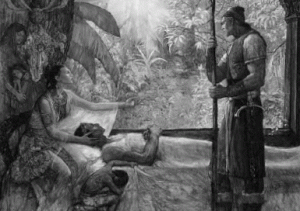
The Queen Sends for Ammon3: Alma 19:2-10
19:5 “…but as for myself, to me he doth not stink.” Nothing of import with this line except to say that it always cracks me up when I read it.
19:10 “Blessed art though because of they exceeding faith…” Notice that he does not say knowledge. In LDS culture, I am worried that “knowledge” always trumps “faith”; that faith is somehow seen as being inferior to knowledge.
The Queen, Ammon3 and Servanats are Overcome: Alma 19:11-16
19:12 The first thing of which King Lamoni testifies is of the Messiah.
Abish Summons the People: Alma 19:17-28
19:17 “…she knew that it was the power of God…” With Abish (only one of two women in the Book of Mormon mentioned by name) Mormon uses the verb “knew” as opposed to using the word “faith” as he did with King Lamoni’s wife (who is never called name).
One of our readers corrected me. EmiG notes:
There are actually six women mentioned by name in the Book of Mormon, though three of them are from the Bible (Eve, Sarah [Abraham’s wife], and Mary). The three whose stories are in the Book of Mormon are Sariah, Abish, and Isabel (Alma 39:3).
19:21 “And they were rebuked by those men who had stood at the waters of Sebus…” Mormon says they were angry, but never really explains if they saw the death of their brethren as being the cause of everyone being prostrate on the ground.
19:23 It is in Alma 17:38 that we find this promise.
Recovery and Conversion: Alma 19:28-36
19:29 Take note everybody, that it was a women who raised the queen up. Like her husband, the queen immediately speaks of Jesus.
19:30 Again we see a women raising someone up. This time it is a man that is brought back to consciousness.19:36 Here we get Momon’s editorial insertion explaining the theological importance of the historical events that have just occured.
Ammon3 and Lamoni Go to Middoni: Alma 20: 1-7
Mormon’s literary ambitions can be seen in the organization of his narratives. While theological implications ar never far away, the exact meaning to be gained from comparing similar stories is often left to readers, while Mormon’s skill (and delight) in constructing narratives is clearly evident. Large-scale parallel narratives are most pronounced early in Mormon’s abridgment, wit the dual deliverances of Alma’s and Limhi’s peoples in the book of Mosiah and the preaching of Alma. Yet it seems that many of the major narratives in the Book of Mormon come in pairs, such as the missionary adventures of Ammon (Alma 17-20) and Aaron (Alma 21-22). The parallels all take the form of fairly extensive narrative, with the numerous structural and verbal correspondences. The sheer abundance of specific narrative repetition in Mormon’s abridgment suggest not only deliberate selection and shaping but also that, in the working out of God’s will, certain kinds of events are likely to recur. In light of Mormon’s artistic structuring of his account with deliberate editing, parallel narratives, and specific verbal connections, Latter-day Saints may want to rethink their long-held assumption that the circumstances of Mormon’s life forced him to write hurriedly. The intentionality implicit in the literary aspects of his history suggests that, from a believer’s perspective, he did not compose as he engraved, but rather transmitted to the plates a text previously written and carefully revised, a process that can thereby explain the many intricate interweavings separated by long passages of text. For outsiders, there will naturally be a higher threshold of skepticism for the identification of large-scale patterns and deliberate allusions – repetitions can always be ascribed to Joseph Smith’s limited vocabulary and imagination – but that imagination may turn out to be more expansive than is generally assumed. (Grant Hardy, Understanding the Book of Mormon, a Reader’s Guide, pg110, 111)
19:33 “…their hearts had been changed…” The idiom “change of heart” with all it variations, appears nine times in the Book of Mormon, seven of which are in Mosiah 5 (Benjamin’s speech) and Alma 5 (Alma’s speech at Zarahemla) These verses include: Mosiah 5:2, 7; Alma 5:7, 12,13,14,26; 19:33; Helaman 15:7
19:36
Mormon tells stories with the unmistakable spiritual meanings, he presents characters as moral exemplars, and he identifies patterns such as “[God’s] arm is extended to all people who will repent and believe on his name”. Yet this observation comes at the conclusion of a specific tale, and is prefaced by “and we see…” It’s crucial to Mormon’s understanding of the world and his own role as a moral guide that the lessons conveyed to readers actually come from the details of history. Properly interpreted, history itself reveals religious truths, and in fact the totality of human experience offers sufficient evidence to demonstrate God’s divine plan and influence in earthly affairs. Or at least this is what Mormon believes. What makes his book interesting is watching how he selects, adapts, and arranges his material, particularly when his sources do not seem to adequately illustrate spiritual verities on their own. Mormon is not simply free to create stories; he is constrained by what he perceives as the facts of history. But through his editing he often highlights certain features or encourages readers to see events in a particular light (Grant Hardy, Understanding the Book of Mormon, a Reader’s Guide, pg 153, 154)
20:3 Do you interpret this as an audible voice or something he heard in his mind?
Ammon3 and Lamoni Meet Lamoni’s Father: Alma 20:8-27
20:13 Here we get the Lamanite tradition of how the Lamanites got the shaft.

Ammon showing King Lamoni’s father who’s boss
20:27 It is actually Aaron2 that visits the King. See Alma 22:1
Ammon3 and Lamoni Rescue Ammon3‘s Brethren: Alma 20:28-30
20:28 “…and Lamoni found favor in the eyes of the King…” Apparently King Lamoni’s father’s permission to go get Ammon’s brethren out of prison was not enough for the King of Middoni to release his prisoners. So how powerful was Lamoni’s father then?
The story of Ammon is picked up again in Alma 21:18.
Aaron2 in Jerusalem and Middoni: Alma 21:1-17
Like Ammon’s story, this is also a flashback.
Aaron2 Preaches in Jerusalem: Alma 21:1-11
21:2 Nothing is known about the origin of the Amalekies (though the name may be an alternate spelling of “Amlicites”; see Alma 2-3. The people of Amulon are the descendants of the priest of Noah2. See Mosiah 23:31-39.
21:7 Just as the first thing of which King Lamoni and his wife testified after being brought back to consciousness, Aaron’s first words are of Christ.
21:7, 8 “…we do not believe in these foolish traditions…” vs 7 points out that one of these traditions is the condescension of Christ.
Aaron2 and His brethren Imprisoned and Rescued: Alma 21:12-17
21:12, 13 Thinking back to Alma and Amulek, it seems that it is only in the cities where there are some converts that the missionaries have problems. When the entire city rejects the missionaries, the missionaries are just kicked out of town. When they get a few converts, they are thrown into prison.
The account of Aaron’s preaching is continued in Alma 22:1
Ammon and Lamoni Return to the Land of Ishmael: Alma 21:18-23
The narrative here is continued from Alma 20:30
21:17 Mormon often incorporates phrases from embedded documents into adjacent narratives by way of preview or summary (in the former case, we must imagine that Mormon knew the contents of his sources before he copied them into his history). In this way he strengthens the overall coherence of his account. Some representative examples include Alma 21:17 and Alma 26:24. “…brought many to the knowledge of the truth; yea, they did convince many of their sins, and of the traditions of their fathers, which were not correct.”(Alma 21:17) Embedded document (Ammon’s testimony): “…bring the Lamanites to the knowledge of the truth?….of the incorrectness of the traditions of their fathers?”(Alma 26:24). (Grant Hardy, Understanding the Book of Mormon, a Reader’s Guide, pg 146)
21:18 “…land of their inheritance…” Who’s inheritance? Alma 17:19 tells us the land was named after the sons of Ishmael “who also became Lamanites.” Should we assume then that this land was specifically settled by and maybe given to the sons of Ishmael?
This ends Ammon’s story in the Land of Ishmael: Alma 17:18-21:23
Aaron2 Teaches the King (the Father of Lamoni): Alma 22:1-14
This is a continuation from Alma 21:17
22:1 “…we will return to the account of Aaron…” This is an editorial interruption by Mormon that Grant Hardy calls a “resumption”
22:6 “If ye well repent ye shall be saved, and if ye will not repent, ye shall be cast out at the last day” This reference is uncertain
22:14 “…bands of death…” This idiom does not occur in the Bible. It appears 12 times in the Book of Mormon: once in Mormon’s account of why Alma began his preaching journey (Alma 4:14), four times in Alma’s sermons, once in Amulek’s defense of Alma(Alma 11:41), and five times in Abinadi’s words. This means that “the bands of death” is almost exclusively associated with Alma and Abinadi, who was the prophet Alma cited in Alma 5:11. The exception would be Alma 22:14. The close connection between the two prophets make sense in terms of the story, in which recalling Abinadi and his words is precisely what Alma is encouraging his listeners to do. (Hardy, pg 135)
22:14 Mormon hopes that the primary sources he inserts will have an effect upon his readers, but they also influence his own writing. There are nearly two hundred instances in which his narration incorporates phrases he has picked up from embedded documents. We see this for instance, when the sons of Mosiah preach to the Lamanites. Through parallel allusion, Mormon tells us indirectly that the converted Lamanites were taught the doctrine of the resurrection. “…the sting of death should be swallowed up …” Which is an obvious echo of 1 Corinthians 15:54, 55. Paul himself is quoting Isaiah 25:8; Hosea 13:14. Compare with Alma 27:28; Mosiah 16:8. This phrase is a favorite of Mormon’s, appearing in his direct appeal to readers in Mormon 7:5.
The King is Overcome and then Raised: Alma 22:13-26
22:15 “…born of God…” This phrase occurs nine times in the Book of Mormon, and eight of those are in quotations from Alma. Although several Nephite prophets preach about becoming children of God, these particular terms are nearly unique to Alma. (Mosiah 27:25, 28; Alma 5:14; 22:15 (Lamanite King); 36:5, 23, 24, 26; 38:6; all New Testament references from 1 John
22:18 “…and if there is a God…” Jared Anderson call’s this King Lamoni’s father’s agnostic prayer.
22:19 “…she was angry with them…” Why is this queen’s reaction different than that of King Lamoni’s wife as found in Alma 19:2?
22:21 How does shifting the responsibility of killing Aaron and his brothers to “the people” instead of the queens’ servants release the queen of any evil that would otherwise come upon her? vs 22 seems to indicate that she was hoping that a riot would break out leading to the death of Aaron and his brothers, thus the queen would not be responsible.
Digression on the Geography of the Promised Land: Alma 22: 27-35
22:27 The content of the proclamation is given in Alama 23:1-3
22:30 “…of whose bones we have spoken…” compare with Omini 1:22; Mosiah 8:8; 21:26
22:32 “…the distance of a day and a half’s journey for a Nephite…” This begs the question, what is a day and a half’s journey for a Nephite? Dr. John L. Sorenson says the following:
The Nephites may have understood that a “day and a half’s journey” meant so many miles. In parallel fashion the Spanish legua (league) meant the distance a loaded mule could travel on the average in an estimated hour; the term said nothing about any particular mule or route or number of hours of consecutive travel. Or the phrase “a Nephite” might imply that a special messenger was the one doing the traveling, for the statement occurs in the context of military defense. And what means of transportation might have been employed? If we assume foot travel – probably the normal mode – we can work toward an estimate of the width of the isthmus. As we have already calculated, the rate for “a Nephite,” a single individual, could potentially be up to six miles an hour for as long as 24 hours within the “day and a half.” That would amount to 144 miles. If some mode of travel other than on foot were used, the 144 figure might be increased. Or the distance might be as little as, say 5o miles. If the low figure applied, it would be harder for Limhi’s explorers to fail to notice they were going through a narrow isthmus; if we push toward the high extreme, the “day and a half’s journey” becomes more troublesome. A plausible compromise range seems to me to be 75 t0 125 miles. (John L. Sorenson, An Ancient American Setting for the Book of Mormon, pg 17)
22:35 “…Omner and Himni…” Is this the first time we get the names of the other sons of Mosiah?

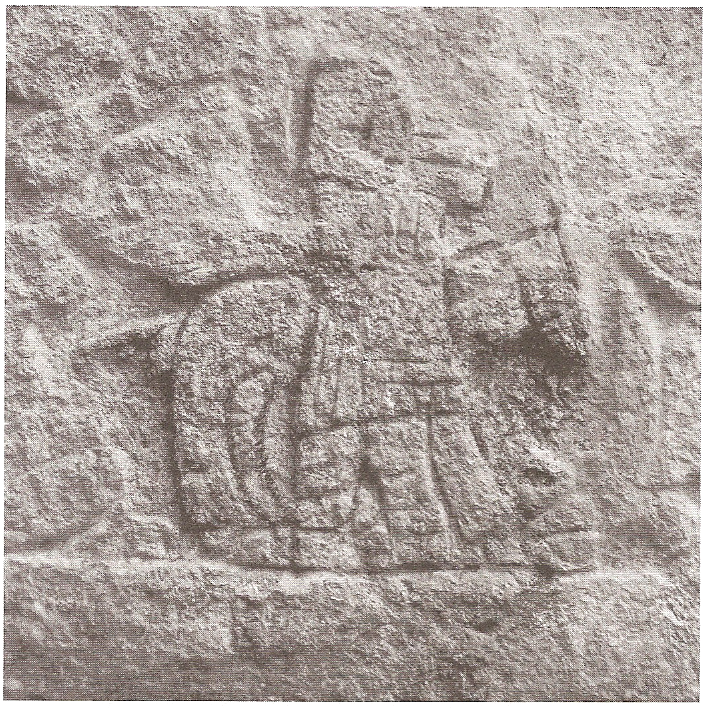
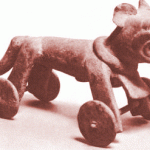



There are actually six women mentioned by name in the Book of Mormon, though three of them are from the Bible (Eve, Sarah [Abraham’s wife], and Mary). The three whose stories are in the Book of Mormon are Sariah, Abish, and Isabel (Alma 39:3).
Thanks for all these insightful points and questions! I enjoy using them to prepare my Gospel Doctrine lessons!
Hey thanks. It’s always great to see we have more readers! If you don’t mind, I am going to change my post to reflect what you wrote.
Mike
“…but as for myself, to me he doth not stink.” Nothing of import with this line except to say that it always cracks me up when I read it.
-We must be brothers! hahaha
Haha same here lol
Great Post. I think I need to read more Hardy. I love the Reader’s Edition of the Book of Mormon he did. It is amazingly better. I study educational psych and the format in my opinion is far superior for retention and comprehension. I will have to look at his other books. I loved the quotes you used. I think I forget that the Book of Mormon had editors and that their world views played a part in the book.
I love Hardy. It’s obvious that I rely heavily on Hardy for my posts. His Reader’s Edition, I love like you do. The way he reformatted the text reads so much better and I pick up things I haven’t noticed before because of the way he re-worked the Book of Mormon. His “Understanding the Book of Mormon” I also love a ton. His “Understanding the Book of Mormon” does not take an apoligetic approach to the Book of Mormon. He approaches it as literature only. It does not go through each book in The Book of Mormon chronologically. Instead, he goes through the Book of Mormon through the view of each of the 3 major historians – Nephi, Mormon, and Moroni.
Thanks for leaving a comment.
MIke
P.S.
My brother Paul and I are going to be on Jared Anderson’s Mormon Stories Sunday School Podcast’s “maiden voyage” recording this Sunday. It should be up by Tuesday for download. Give it a listen and let us know if we sounded like complete tools.
Mike
The Nephites may have understood that a “day and a half’s journey” meant so many miles. In parallel fashion the Spanish legua (league) meant the distance a loaded mule could travel on the average in an estimated hour; the term said nothing about any particular mule or route or number of hours of consecutive travel. Or the phrase “a Nephite” might imply that a special messenger was the one doing the traveling, for the statement occurs in the context of military defense. And what means of transportation might have been employed? If we assume foot travel – probably the normal mode – we can work toward an estimate of the width of the isthmus. As we have already calculated, the rate for “a Nephite,” a single individual, could potentially be up to six miles an hour for as long as 24 hours within the “day and a half.” That would amount to 144 miles. If some mode of travel other than on foot were used, the 144 figure might be increased. Or the distance might be as little as, say 5o miles. If the low figure applied, it would be harder for Limhi’s explorers to fail to notice they were going through a narrow isthmus; if we push toward the high extreme, the “day and a half’s journey” becomes more troublesome. A plausible compromise range seems to me to be 75 t0 125 miles. (John L. Sorenson, An Ancient American Setting for the Book of Mormon, pg 17)
Or they could have hooked up their chariots and made the distance in half the time.
Horses, and chariots, and steel! Oh my!! Ha